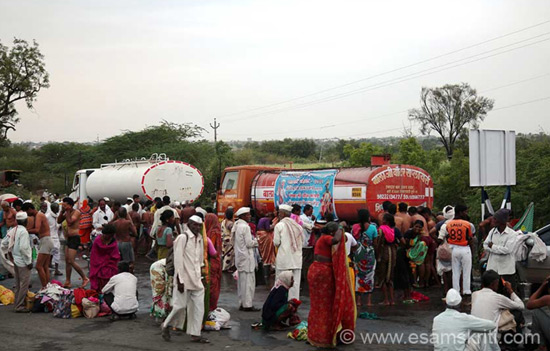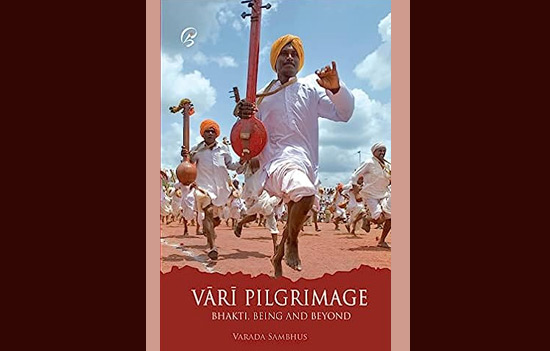- Know how VARI is a manifestation of spiritual democracy and an instrument of social churning. It is believed that works of sects like Varkari and saints provided the background for the Maratha renaissance that started with Shivaji Maharaj.
One of the cornerstones of Maharashtrian culture and Marathi identity is
the tradition of the Vari pilgrimage. The Marathi synonym
for Vari is yerzara,1 meaning “going to and coming back from” repetitively, at frequent intervals.
The term ‘Vari’ is unequivocally associated with yearly pilgrimage of the Varkari to Pandharpur. There are several pilgrimages in India and Maharashtra, some of which are annual pilgrimages, like that of Khandoba of Jejuri.2
However, the term ‘Vari’ is exclusively used to connote the pilgrimage to Pandharpur, which revolves around the deity Viththala or Panduranga. The pilgrimage - Vari; the sacred place - Pandharpur; and the deity - Panduranga/Viththala - are inextricably linked. In common parlance, Vari is also called “palkhi sohala”, “palkhi”, “Ashadhi”, and “dindi sohala”. It seems that for Varkaris, Vari always means something more than a physical journey from home to Pandharpur. This “something more” may differ from individual to individual based on their beliefs, aspirations, spiritual lineage, etc.
 Pandharpur Vari 2015.
Pandharpur Vari 2015.
Vari is essentially a collective affair and accords the highest
importance to walking with fellow Varkaris and in the company of righteous
beings (santasanga).3 The collective elements of Vari are exhibited in walking
together and in singing, dancing, playing, eating and staying together. The Vari includes singing abhangas,
dancing during kirtanas and bharudas, playing local games like phugadi, and
listening to the discourse or pravachana.
In this sense, Vari is a public manifestation of bhakti, expressed by visiting Pandharpur at frequent intervals, usually once every year. A Varkari can choose to go on any one of the four pilgrimages taking place in the months of Chaitra, Ashadha, Kartika, Magha. Even though any of these four pilgrimages are referred to as Vari, the term is commonly adopted to refer to the Ashadha pilgrimage. The Ashadha pilgrimage is the largest and most famous of all. Most Varkaris prefer Ashadha pilgrimage because it suits their agricultural calendar.
It is important to note that the sense of community during the Vari pilgrimage is not restricted to the Varkaris alone (in the narrowest sense of the term) but expands to every individual who is even remotely associated with the Vari. The community includes various sections of people – the Varkaris who are initiated into the Sampradaya, as well as all those who take part in the Vari pilgrimage – even without being initiated into the Sampradaya, those who do not walk the entire distance but just a few miles or for a few days according to their convenience and ability.
 All Varis being served by water tankers without distinction. Pandharpur Vari 2015.
All Varis being served by water tankers without distinction. Pandharpur Vari 2015.
The community constituted
during the Vari pilgrimage also includes the sevekaris - those who provide
various kinds of seva with or without payment, like the devotees who want to
offer food to the pilgrims or even the shopkeepers, police personnel, doctors,
and volunteers from the NGOs. It is inclusive of the local people who come to
take darshan of the palkhi or go to attend kirtanas and pravachanas, or the
individuals involved in local administration who are instrumental in providing
administrative support to the palkhi procession. The community that takes form
during the Vari pilgrimage is not devoid of politicians. The volunteers and
leaders of various political parties use the platform of the Vari to propagate
their interests. They, too, are accommodated within the idea of the community
during the Vari pilgrimage.
This sense of community is well understood by the fact that every person on the way to Pandharpur during the Vari pilgrimage is called “mauli”. The deity Panduranga, the santas of the tradition, the initiated and the non-initiated pilgrims, the sevekaris, the representatives of the government and the non-government agencies all are called “mauli”.
Through the means of Vari, a platform is made available to every
individual, irrespective of differences of class, caste, gender, education, and
occupation, to pursue their spiritual quest and attain great heights by
following in the footsteps of santas of the Varkari tradition. The Vari
pilgrimage is the public manifestation of collective ways of bhakti.
The Vari and the
other bhakti practices like kirtana, pravachana, bharuda employed during the Vari
help intertwine the message of spirituality with the immediate and day-to-day
concerns of the people. Though it is true
that the Vari holds significant spiritual and transcendental merit, it is, at
the same time, - worldly affair, providing a space for shaping,
reshaping, and negotiating the social ethos and public culture. It allows every
individual representation and opportunity to achieve the highest possible
spiritual goal as well as lead others on the same path by achieving the heights
of santahood. Vari kept the spaces inclusive and open for dialogue and
negotiation. The Vari is manifestation of spiritual democracy and has served as
an instrument of social churning for at least eight hundred years.
*For a detailed discussion on the Vari pilgrimage and its socio-political and cultural dimensions, please refer to the book by this author ‘Vari Pilgrimage: Bhakti, Being and Beyond’
References
1. S. V. Dandekar, one of the most respected personalities in the Varkari Sampradaya,
also adopts this meaning of the term Vari. See, Dandekar, Varkari Panthacha
Itihas.
2. Khandoba is a folk god of a Shaiv tradition. The main temple is in
Jejuri in Pune District in Maharashtra. For details, see, R. C. Dhere, Dakshinecha
Lokdev Shri Khandoba (Pune: Padmagandha Prakashan, 2016). Also see, G.D.
Sontheimer, Anne Feldhaus, et. al. King of Hunters Warriors and Shepherds: Essays on Khandoba (New Delhi: IGNCA & Manohar, 1997).
3. Sambhus, Varada. Vari Pilgrimage: Bhakti, Being
and Beyond. New Delhi: Indus Scrolls Press, 2023.
About Author Dr Varada
Sambhus is an Assistant Professor of Political Science at Maharashtra National Law University, Mumbai, Maharashtra. She completed her Ph.D. on ‘Pilgrimage and the Bhakti Public: A Study of Varkari Practices in Maharashtra’ from Jawaharlal Nehru University, New Delhi. She was a research fellow at Nehru Memorial Museum and Library, New Delhi. Exploring socio-political dimensions of bhakti and religion is her core research area.

To buy book Vari Pilgrimage: Bhakti, Being and Beyond Online
Also read
1. Vithoba
of Pandharpur
2. Album
Pandharpur Wari
3. Album
Pandarpur Ringan
4. Warkari
Movement
5. Sant
Dyaneshwar Pioneer of the Bhakti Movement
6. Album
Khandoba Temple, Jejuri